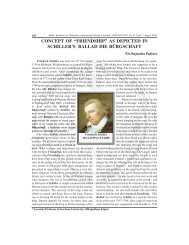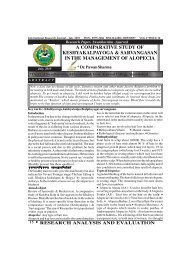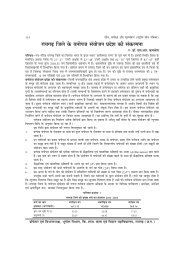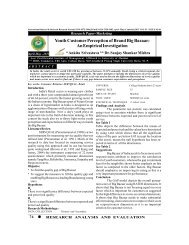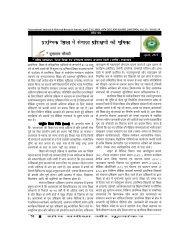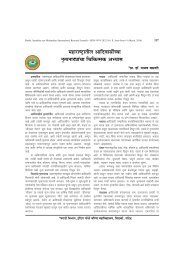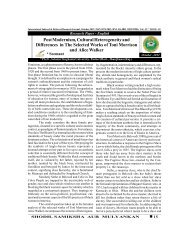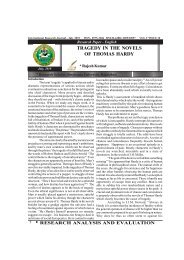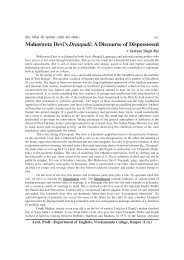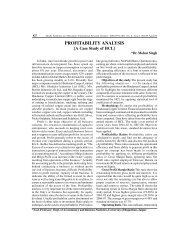graecum l. cell suspension culture. - international indexed refereed ...
graecum l. cell suspension culture. - international indexed refereed ...
graecum l. cell suspension culture. - international indexed refereed ...
You also want an ePaper? Increase the reach of your titles
YUMPU automatically turns print PDFs into web optimized ePapers that Google loves.
International Referred Reseach Journal,February,2011 ISSN-0975-3486 RNI: RAJBIL 2009/300097 VOL-I *ISSUE 17<br />
February, 2011<br />
Research Paper—Environmental Science<br />
EFFECT OF SALICYLIC ACID ON<br />
TRIGONELLINE PRODUCTION IN TRIGONELLA<br />
FOENUM- GRAECUM L. CELL<br />
SUSPENSION CULTURE.<br />
* Laxmi Mathur ** Rajesh Kr. Yadav<br />
*-** Dept. of Environmental Science, S.S. Jain Subodh (PG) College, Jaipur<br />
A B S T R A C T<br />
Trigonelline (a pyridine alkaloid) was extracted from callus of Trigonella foenum-<strong>graecum</strong>. Cell <strong>suspension</strong><br />
<strong>culture</strong> of T. foenum-<strong>graecum</strong> was prepared to study the effect of elicitation. Two concentration doses of<br />
salicylic acid (viz. 0.025 mM and 0.05 mM) were used as elicitor in the <strong>cell</strong> <strong>suspension</strong> <strong>culture</strong>. A two fold<br />
increase in trigonelline production was observed at a concentration dose of 0.025 mM, while an increase<br />
was also observed at 0.05mM concentration dose of salicylic acid.<br />
Key words: Trigonelline, Trigonella foenum-<strong>graecum</strong>, Cell <strong>suspension</strong> <strong>culture</strong>, Elicitation, Salicylic acid.<br />
Introduction:<br />
Secondary metabolites are the compounds which play<br />
an important role in plant defense mechanism.<br />
Trigonelline, one of the pyridine alkaloid is widely<br />
distributed in the plant Kingdom (Taguchi et. al., 1985).<br />
Elicitation can enhance the efficiency of product<br />
accumulation in <strong>cell</strong> <strong>culture</strong>s reducing the time required<br />
to obtain a product (Wiznsama et. al., 1985).<br />
Trigonella foenum-<strong>graecum</strong> L. commonly<br />
known as fenugreek (Methis) is a rich source of<br />
trigonelline. Enhancement in trigonelline content in<br />
<strong>cell</strong> <strong>suspension</strong> <strong>culture</strong> of T. foenum-<strong>graecum</strong> using<br />
salicylic acid as an elicitor showed a significant increase<br />
at dose level of 0.025 mM and 0.05 mM concentrations<br />
of salicylic acid as compared to normal callus.<br />
Material and Methods:<br />
Cell <strong>suspension</strong> <strong>culture</strong>s of T. foenum-<strong>graecum</strong><br />
were grown in liquid MS medium. Salicylic acid (Merck<br />
India Ltd.) was used as an elicitor, two concentration<br />
doses of salicylic acid (0.025 mM and 0.05 mm) were<br />
added in both the sets of experiment, separately by<br />
using erilson’s micropipette.<br />
The flasks were incubated on shaker for 24<br />
hours of incubation; callus tissue was weighed and<br />
separated from the medium by filtration through<br />
Whatmann filter paper. Both tissue and <strong>culture</strong> medium<br />
were used for extraction and estimation of their<br />
trigonelline content.<br />
The dried callus samples and <strong>culture</strong> medium<br />
were extracted and analysed according to method of<br />
Kogan et. al. (1953). The extracted samples were<br />
dissolved in 0.5 ml methanol and co-chromatographed<br />
on tlc along with standard trigonelline.<br />
Results:<br />
The effect of low concentration doses (0.025<br />
mM and 0.05 mM) of salicylic acid on the production<br />
of trigonelline was observed with control. The callus<br />
growth was not effected throughout the experiment,<br />
while a very significant two fold increase (0.59%) in<br />
trigonelline content was observed in 0.025 mM<br />
treatment dose of salicylic acid over the control. The<br />
trigonelline content was also increased (0.39%) in 0.05<br />
mM (Table-1).<br />
Table – 1<br />
Effect of different dose treatment of Salicylic acid on<br />
trigonelline content in T. foenum-graceum <strong>cell</strong><br />
<strong>suspension</strong> <strong>culture</strong>.<br />
Control<br />
Trigonelline<br />
Salicylic acid dose<br />
0.025 mM 0.05mM<br />
(%) 0.27 0.59 0.39<br />
Discussions:<br />
Elicitor in <strong>cell</strong> <strong>culture</strong>s offer a novel approach<br />
for rapid accumulation of certain secondary metabolites<br />
by reducing time required to obtain the efficiency of<br />
product (Kamal et. al. 1995). Rokem et. al. (1984) reported<br />
70% increase in disogenin content from Dioscorea<br />
deoltoidea <strong>cell</strong> <strong>culture</strong>s by using homogenate of<br />
Rhizopous arrhizus.Salicylic alcohol and salicylic acid<br />
are the basic compound of salicylate an important group<br />
of pharmaceutical agents.<br />
R E S E A R C H A N A L Y S I S A N D E V A L U A T I O N 137
International Referred Reseach Journal,February,2011 ISSN-0975-3486 RNI: RAJBIL 2009/300097 VOL-I *ISSUE 17<br />
It has been observed that application of recovery in the tissue was highly significant in<br />
exogenous salicylic acid induces expression of defense comparison to control.This increase in trigonelline<br />
related genes and provides partial protection against content can also be co-related with the studies of Kamal<br />
pathogen.Ward (1991) reported salicylic acid plays an et. al. (1995), that the salicylic acid might be acting as<br />
important role in disease resistant in tobacco.In the a signal compound in the induction of plant defense<br />
present study two months old callus <strong>culture</strong> of T. mechanism thereby increasing the production of<br />
foenum-<strong>graecum</strong> were fed with different treatment secondary metabolites specifically trigonelline in the<br />
doses of salicylic acid in the medium. Trigonelline present investigations on T. foenum-<strong>graecum</strong>.<br />
R E F E R E N C E<br />
Kamal, R., Moreno, P.R. H. and Verpoorte, R. 1995. Effect of elicitors on production of alkaloid and enzymes activities of<br />
Catharanthus roseus <strong>suspension</strong> <strong>culture</strong>d <strong>cell</strong>s. Plant Cell, Tissue and Organ Culture.Rokey, J.S., Schwarzberg, J. and Godbetry,<br />
J. 1984. Autoclaved fungal mycelia increase disogenin production in <strong>cell</strong> <strong>suspension</strong> <strong>culture</strong> of Dioscorea delotoiedea Plant<br />
Cell Rep. 3; 159-160.Taguchi, H., Muneto, S. and Shimabayushi, Y. 1986. Content of quinolic acid trigonelline and M. methyl<br />
nicotinamide in various food and thermal conversion of acid and nicotinamide. Betamin 60(11); 537-546.Warel, E.R., Ukhers,<br />
S.J. William, S.C. Diches, S.S., Wiederhol, D.L., Alexander, D.C., Ahil-evrg, P., Metrauo, J.P. and Ryeul, J.A. 1991. Plant Cell<br />
3; 1085-1094.Warren, L. 1959. The Triobarbituric acid assay of sialic acids! J. Biol. Chem.,234; 1971.<br />
138<br />
R E S E A R C H A N A L Y S I S A N D E V A L U A T I O N



